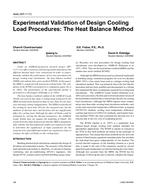Description
Under an ASHRAE-sponsored research project (RP-1117), two office-sized test cells having identical geometry but different thermal mass were constructed in order to experimentally validate the performance of two new procedures for design cooling load calculations: the heat balance method (HBM) and radiant time series method (RTSM). In this paper, the HBM is compared with measured cooling loads. The validation of the RTSM is presented in a companion paper (Iu et al. 2003). The performance of the experimental facility is presented in a third paper (Eldridge et al. 2003). The heat balance method codified in the ASHRAE Loads Toolkit was used in this study. Cooling loads predicted by the HBM deviated from measured data by less than 4% for base case and drop ceiling configurations. The HBM overpredicted the cooling by more than 10% for the carpeted zone, but the addition of thermal mass and furniture did not significantly affect the cooling load. Although the effect of blinds could be estimated by varying the thermal parameters, the ASHRAE Loads Toolkit does not support the modeling of blinds. The results from this study demonstrate that the HBM is fundamentally reliable, but that additional studies are required in order to determine the significance of input parameters for the carpeted zone and additional models are required in order to estimate the effect of blinds on the cooling load.
Units: Dual
Citation: ASHRAE Transactions, vol. 109, pt. 1
Product Details
- Published:
- 2003
- Number of Pages:
- 14
- File Size:
- 1 file , 610 KB
- Product Code(s):
- D-20921




